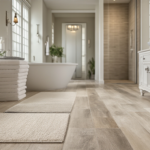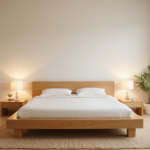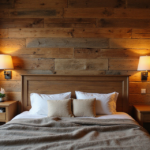Creating a traditional dining room that exudes timeless elegance while remaining functional for modern living requires more than simply arranging furniture. It’s about crafting a space where every element—from the carefully selected dining table to the thoughtfully curated wall art—works in harmony to tell your family’s story while honoring classic design principles that have endured for generations.
The magic of traditional design lies in its ability to create rooms that feel both grand and intimate, sophisticated yet welcoming. When executed thoughtfully, a traditional dining room becomes more than just a place to eat; it transforms into the heart of your home where memories are made, conversations flow freely, and the art of gracious living is celebrated daily.
This comprehensive guide presents 23 expert-backed strategies to help you design a traditional dining room that will remain beautiful and relevant for decades to come. Each tip builds upon the others, creating a cohesive approach that balances historical authenticity with contemporary comfort, ensuring your space reflects both timeless elegance and your unique personal style.
1. Select the Perfect Dining Table Size for Your Space
Choosing the correct dining table size serves as the foundation for everything else in your traditional dining room design. A properly sized table ensures comfortable seating for your family while allowing adequate space for movement and serving. The right proportions create visual harmony that makes even modest spaces feel grand and purposeful, while poor sizing can make a room feel cramped or awkwardly sparse.
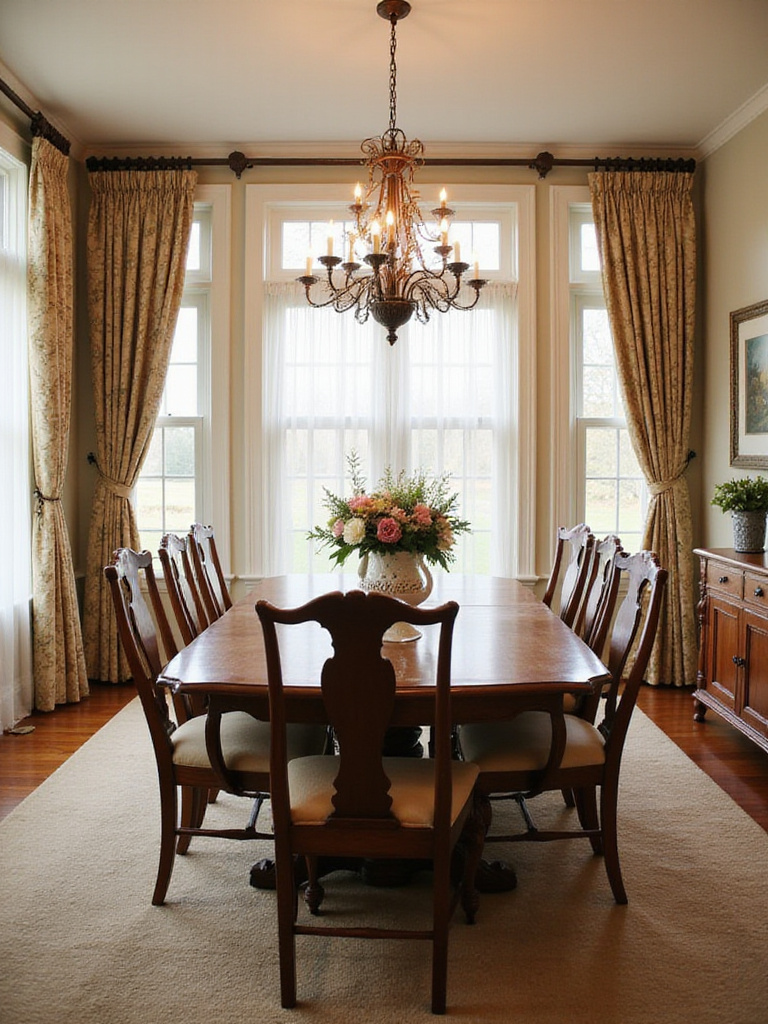
Beyond aesthetics, proper table sizing directly impacts functionality and flow. You’ll need at least 36 inches of clearance around the table for chairs to pull out comfortably, with 42-48 inches being ideal for high-traffic areas. Calculate your maximum table dimensions by subtracting the required clearance from your room’s total measurements. For example, a 12×14 foot room can accommodate a table no larger than 6×8 feet, allowing for that crucial circulation space that makes dining comfortable rather than cramped.
The artisan collective that creates these pieces understands that proportion is everything in traditional design—your table should anchor the space without overwhelming it.
2. Pair Dining Chairs for Cohesive Traditional Elegance
Achieving visual harmony in your traditional dining room requires dining chairs that speak the same design language, whether through shared materials, similar silhouettes, or complementary details. This cohesion creates the sophisticated, intentional look that defines timeless traditional spaces. Mismatched chairs, regardless of their individual beauty, can make even the most expensive dining room feel haphazard and unfinished.
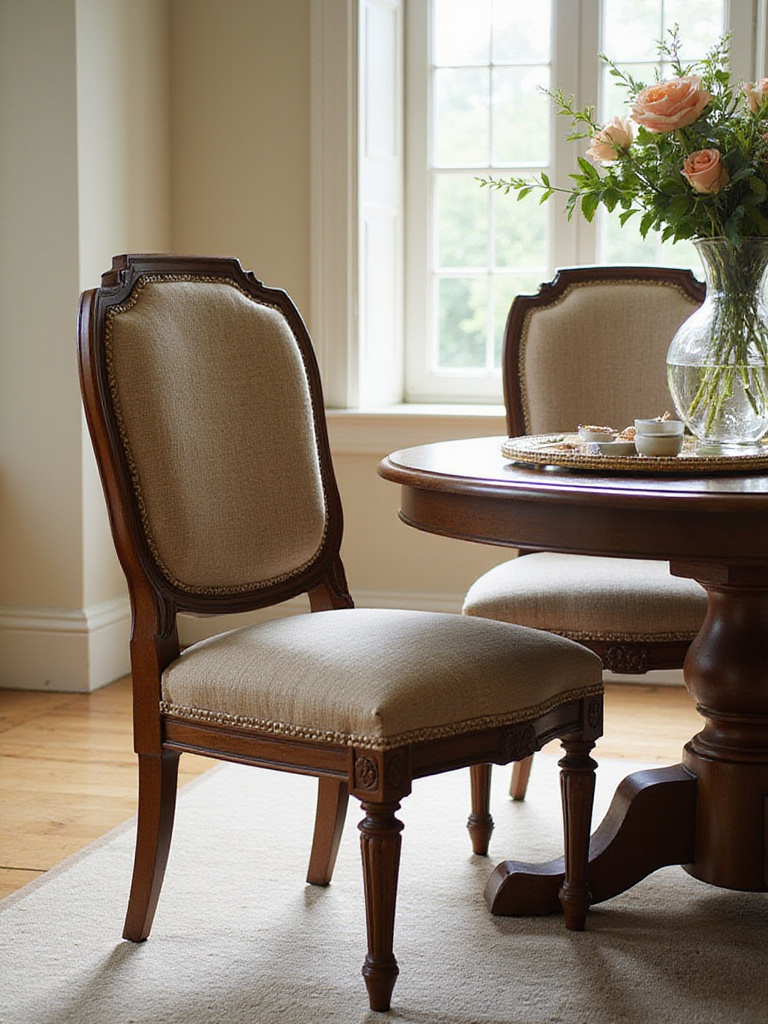
The key lies in finding chairs that share fundamental characteristics while allowing for subtle variations that add interest. Consider selecting eight matching side chairs with two slightly different host chairs at the table’s head—perhaps the same Chippendale style but with upholstered seats versus cane backs. This approach maintains visual unity while creating hierarchy and preventing monotony. Pay attention to wood tones, ensuring they either match precisely or complement each other within a cohesive palette.
- Choose chairs with similar leg styles (cabriole, straight, or fluted) for foundational consistency
- Harmonize wood finishes and upholstery fabrics within your chosen color scheme
- Consider comfort alongside aesthetics—traditional doesn’t mean uncomfortable
- Invest in quality construction with solid wood frames and proper joinery
The craftsmanship reveals itself in details like the way these chairs will age gracefully, developing character rather than showing wear.
3. Maximize Storage with a Functional Traditional Buffet
A well-chosen buffet or sideboard serves as both the workhorse and the showpiece of your traditional dining room, providing essential storage while offering a surface for serving and display. This piece consolidates your entertaining essentials—fine china, crystal, serving pieces, and linens—keeping them organized and accessible while maintaining the uncluttered aesthetic that traditional design demands. Without adequate storage, even the most beautiful dining room can quickly become chaotic.

The internal configuration of your buffet matters as much as its external appearance. Look for felt-lined drawers to protect silverware, adjustable shelves to accommodate various plate sizes, and deep cabinets for large serving pieces. A quality buffet can store complete place settings for twelve while providing counter space for serving dishes during gatherings. This dual functionality allows your dining table to remain clear and beautiful while ensuring everything needed for gracious entertaining remains within easy reach.
- Assess your storage needs before purchasing by inventorying your dining-related items
- Prioritize quality construction with solid wood and traditional joinery methods
- Choose internal features like felt lining and adjustable shelves for maximum utility
- Ensure proper proportions—the buffet should complement, not compete with your table
Beyond the obvious placement, consider using this piece as a foundation for seasonal displays that keep your room feeling fresh throughout the year.
4. Showcase Heirlooms in a Classic China Cabinet
A traditional china cabinet transforms family treasures from hidden storage into cherished displays, creating conversation starters while preserving precious memories for future generations. This piece serves as a curated gallery for your most meaningful possessions—grandmother’s wedding china, crystal collected during travels, or silver passed down through generations. The visibility ensures these treasures remain part of daily life rather than forgotten in boxes.
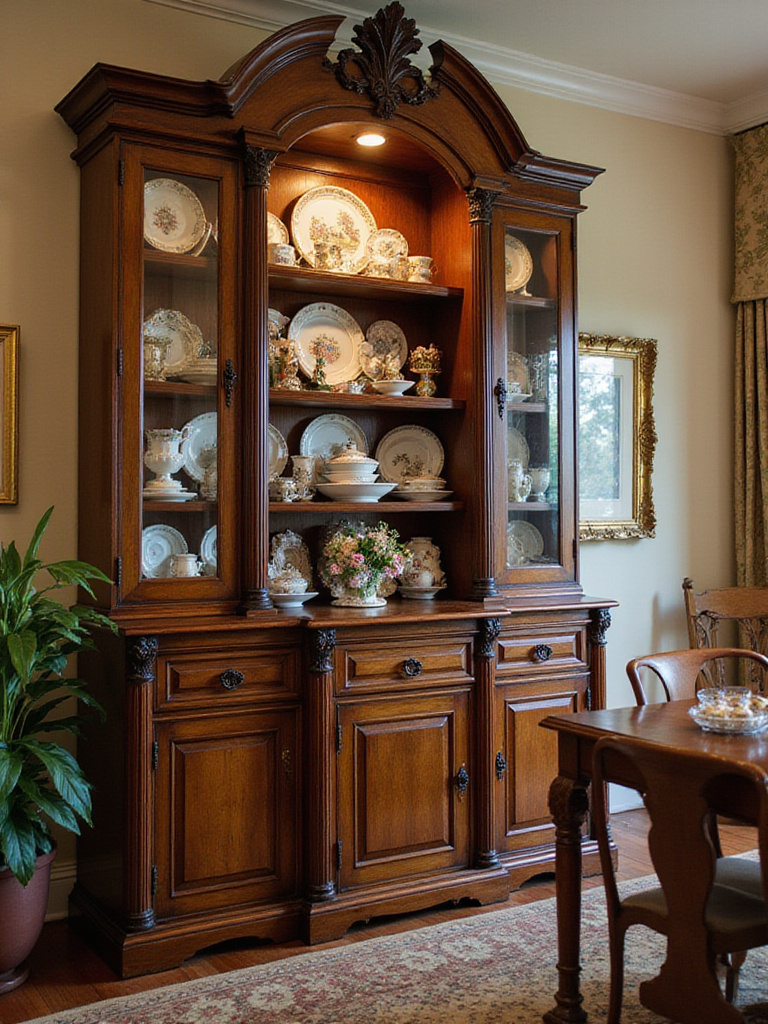
Strategic arrangement within your china cabinet creates visual impact while protecting delicate items. Group similar pieces together, vary heights for interest, and leave breathing room between objects. Internal lighting transforms the display from mere storage to sophisticated showcase, while mirrored backs can double the visual impact and reflect light throughout the room. Consider rotating displays seasonally to keep the arrangement fresh and allow different pieces their moment to shine.
- Select a cabinet style that complements your dining room’s architectural details
- Install LED strip lighting for safety and optimal illumination
- Use plate stands and risers to create dynamic arrangements at varying heights
- Rotate displays periodically to showcase different collections and prevent monotony
The environmental story behind this piece began with craftsmen who understood that furniture should serve multiple generations, not just one.
5. Optimize Your Dining Room Layout for Seamless Flow
Creating an optimal layout requires understanding how people naturally move through and use your dining space. The goal is eliminating bottlenecks while maximizing both comfort and functionality. Poor layout planning can turn even the most beautiful traditional dining room into a frustrating space where guests feel cramped and servers struggle to navigate. Thoughtful arrangement, however, makes every gathering feel effortless and elegant.

Traffic flow becomes especially critical during entertaining when multiple people need to move around the table simultaneously. Ensure primary pathways remain at least 36 inches wide, with 42-48 inches preferred for major routes between kitchen and dining areas. Position your buffet or sideboard along walls that don’t interrupt natural flow patterns, and consider how doors, windows, and architectural features affect furniture placement. Round tables often work better than rectangular ones in rooms with multiple entry points.
- Measure and map your space accurately before selecting furniture
- Use painter’s tape to outline proposed furniture placement on the floor
- Ensure adequate clearance behind chairs for comfortable seating and movement
- Consider sight lines from the kitchen and adjacent rooms for better connection
Professional stylists approach this by first identifying the room’s natural focal points and building the arrangement around them.
6. Install a Statement Chandelier for Grand Illumination
The right chandelier serves as jewelry for your traditional dining room, providing essential ambient lighting while establishing a dramatic focal point that sets the tone for elegant gatherings. This single fixture can transform an ordinary space into something extraordinary, creating the kind of sophisticated atmosphere that makes every meal feel special. The interplay between style, scale, and placement determines whether your chandelier enhances or overwhelms the space.
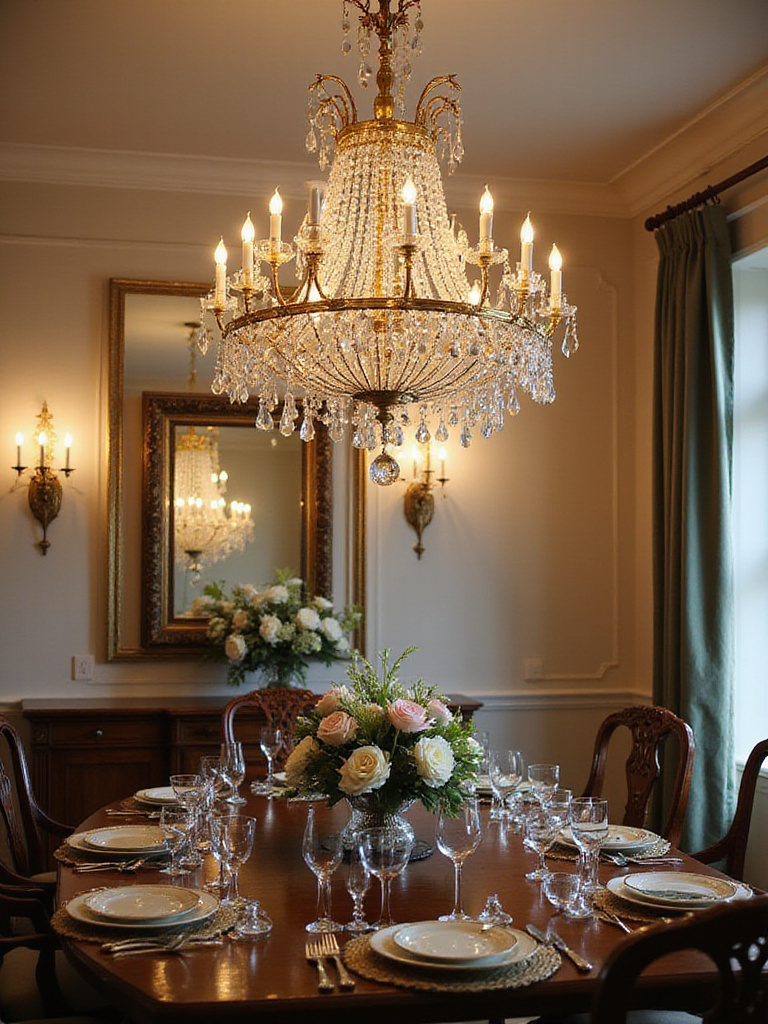
Proper sizing follows a simple formula: add your room’s length and width in feet, and the sum in inches gives you the ideal chandelier diameter. A 12×14 foot room, for example, calls for a 26-inch diameter fixture. Hanging height matters equally—30-36 inches above the table for standard 8-foot ceilings, adjusting upward for higher ceilings. Choose traditional materials like crystal, brass, or wrought iron in styles that complement your room’s architectural character.
- Calculate proper size using room dimensions for proportional scale
- Select materials and finishes that harmonize with existing hardware
- Install dimmer switches for versatile mood lighting throughout the day
- Consider the chandelier’s relationship to other light sources in the room
The unexpected pairing that always works is combining your statement chandelier with subtle wall sconces for layered illumination.
7. Add Layered Lighting with Elegant Wall Sconces
Wall sconces provide the crucial middle layer of lighting that transforms a traditional dining room from merely functional to genuinely atmospheric. While your chandelier handles general illumination, sconces create warm pools of light that highlight architectural details, reduce harsh shadows, and add visual depth to the space. This layered approach eliminates the flat, institutional feeling that comes from relying on a single light source.
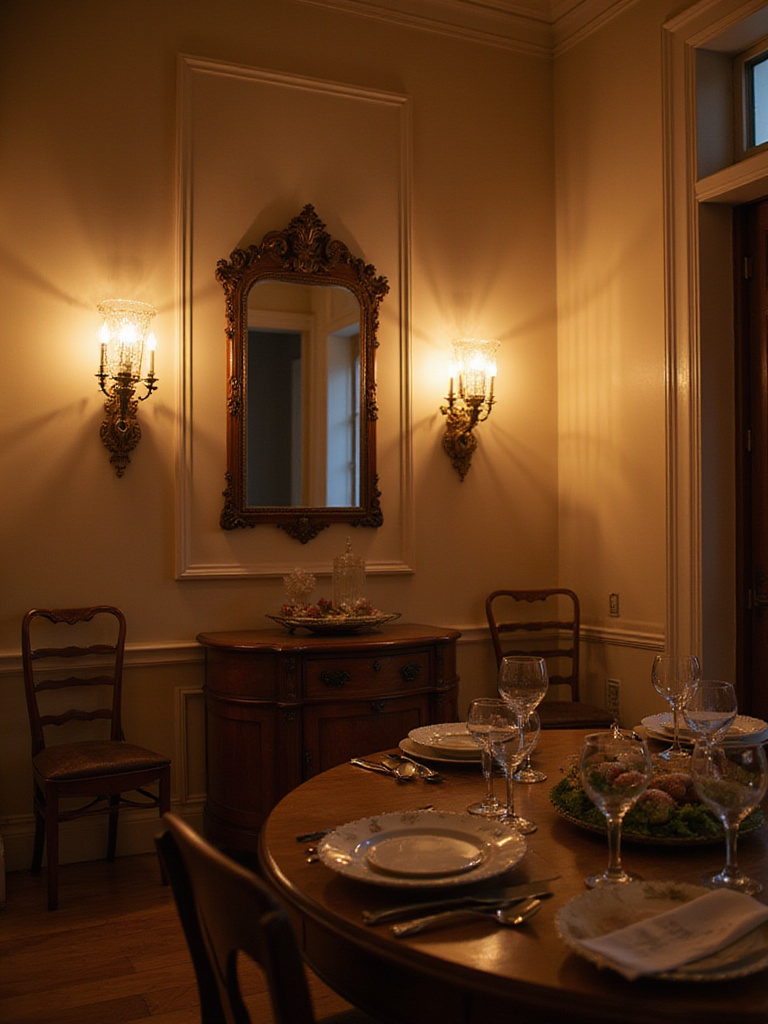
Strategic placement of sconces requires considering both function and aesthetics. Install them at eye level when seated—typically 60-66 inches from the floor—to prevent glare while maximizing their ambient contribution. Symmetrical placement on either side of artwork, windows, or a buffet creates the balanced composition that traditional design celebrates. Choose styles that complement your chandelier while adding their own character, perhaps matching the metal finish while varying the shade or crystal details.
- Position sconces to complement rather than compete with your central chandelier
- Use dimmer controls for precise ambiance adjustment throughout different occasions
- Select styles that echo your room’s traditional aesthetic through materials and proportions
- Consider how sconce light will interact with wall colors and textures
The visual weight balances perfectly when you layer these fixtures with your existing chandelier and perhaps add buffet lamps for complete illumination.
8. Anchor Your Space with a Luxurious Area Rug
A properly sized area rug grounds your dining furniture and defines the eating area within larger spaces, preventing your beautiful traditional pieces from appearing to float disconnected from each other. The rug also provides acoustic benefits, softening the sounds of conversation and chair movement while adding warmth and texture that hard surfaces cannot achieve. This foundation piece can unify disparate elements and introduce color or pattern that enhances your overall design scheme.

Size matters critically with dining room rugs—the rug should extend at least 24-30 inches beyond your table on all sides, ensuring dining chairs remain on the rug even when pulled out for seating. This prevents the jarring visual and physical interruption of chair legs catching on rug edges. Choose low-pile materials like wool or quality synthetics that can withstand chair movement while providing easy maintenance for inevitable spills.
- Measure carefully to ensure the rug accommodates both table and chairs when in use
- Select durable, stain-resistant materials appropriate for dining room traffic
- Choose patterns and colors that complement rather than compete with other room elements
- Invest in a quality rug pad for safety, comfort, and rug longevity
The tactile experience changes the entire room’s energy when you step from hard flooring onto the soft, welcoming surface of a well-chosen rug.
9. Frame Windows with Timeless Drapery Panels
Elegant drapery panels provide the softness and sophistication that traditional dining rooms require, framing views while offering practical benefits like light control and improved acoustics. Quality window treatments can reduce energy costs, provide privacy when needed, and serve as significant design elements that enhance your room’s architectural character. The right drapery transforms stark windows into gracious focal points that complement your traditional aesthetic.
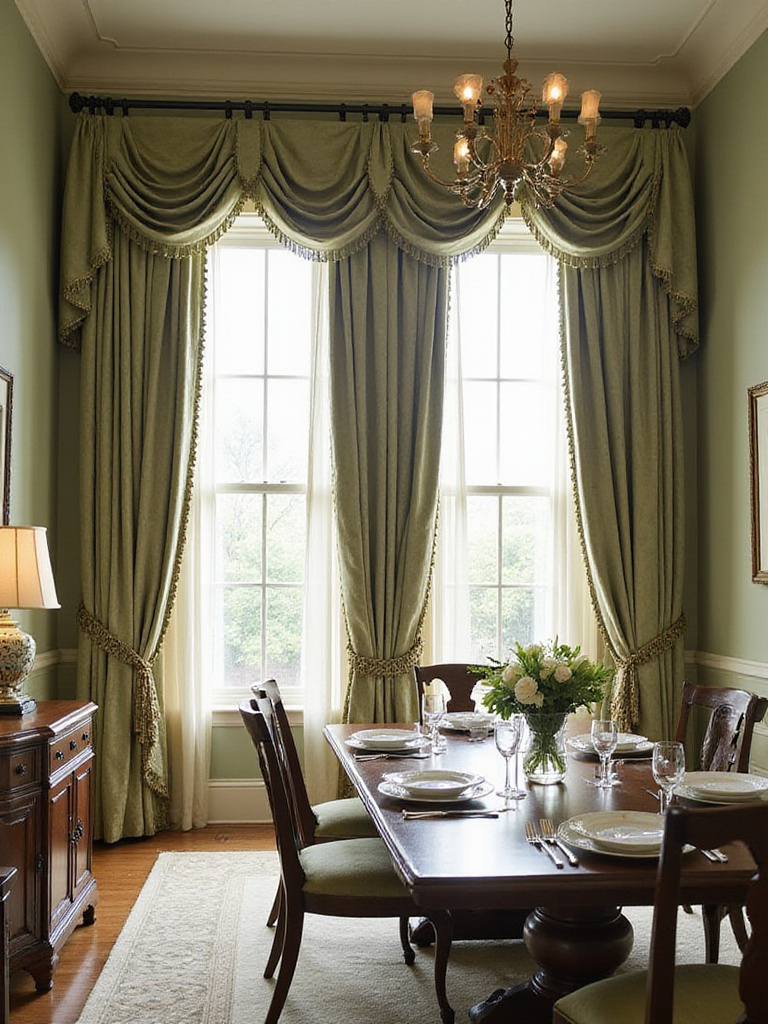
Proper installation and proportion make the difference between amateur and professional results. Mount drapery rods 4-6 inches wider than the window frame and 6-12 inches above it to create the illusion of larger windows and higher ceilings. Panels should “kiss” the floor or puddle slightly for luxurious traditional appeal, while proper fullness—2 to 2.5 times the window width—ensures rich, gathered appearance when closed. Always include lining for durability, light control, and improved insulation.
- Choose classic fabrics like linen, silk, or velvet in colors that enhance your overall palette
- Ensure proper measurements for professional-looking length and fullness
- Select hardware that complements other metallic finishes in the room
- Consider functionality needs like light filtering or room darkening capabilities
The interplay between the colors creates depth and richness that changes throughout the day as natural light shifts.
10. Select Rich Color Palettes for Classic Ambiance
Deep, saturated colors provide the sophisticated backdrop that allows traditional furniture and accessories to truly shine, creating the kind of enveloping atmosphere that makes dining rooms feel intimate and luxurious. Rich palettes—think deep blues, warm burgundies, forest greens, or sophisticated grays—establish emotional depth and visual weight that shallow, trendy colors cannot achieve. These colors also hide minor imperfections while creating a sense of permanence and quality.
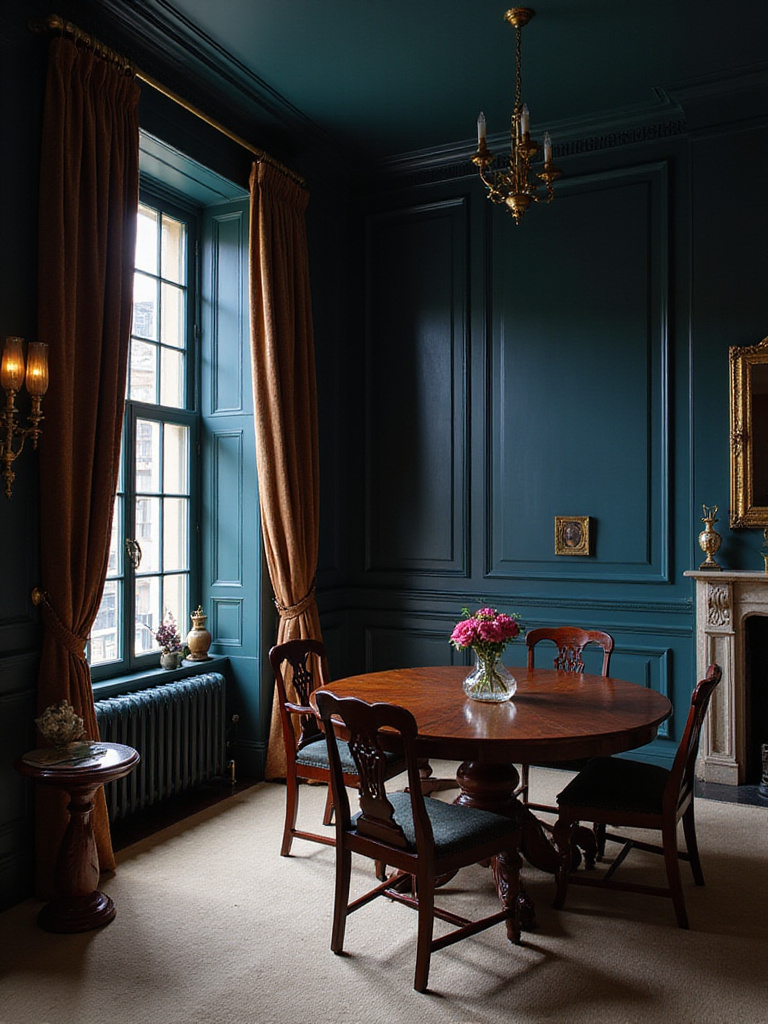
The key to success with rich colors lies in balancing them with adequate lighting and complementary lighter tones. Use the 60-30-10 rule: your dominant rich color covers 60% of the space (walls), a secondary color handles 30% (upholstery, drapery), and an accent color provides 10% of interest (accessories, art). Natural light levels in your room determine how deep you can go—rooms with excellent natural light can handle more saturated tones than darker spaces.
- Research historical color palettes from your preferred traditional period for authenticity
- Test colors in different lighting conditions throughout the day before committing
- Balance rich wall colors with lighter ceiling and trim colors for proper proportion
- Consider how colors will interact with your existing furniture and flooring
The heritage technique gets a contemporary update through modern paint formulations that provide better coverage and durability than historical options.
11. Curate Wall Art and Mirrors for Sophisticated Appeal
Thoughtfully selected wall art and strategically placed mirrors elevate your traditional dining room from simply furnished to genuinely sophisticated, creating focal points while reflecting light and expanding visual space. Art provides personality and cultural depth, while mirrors serve the practical purpose of brightening the room and creating the illusion of greater space. The combination of both elements adds layers of visual interest that keep the eye engaged.
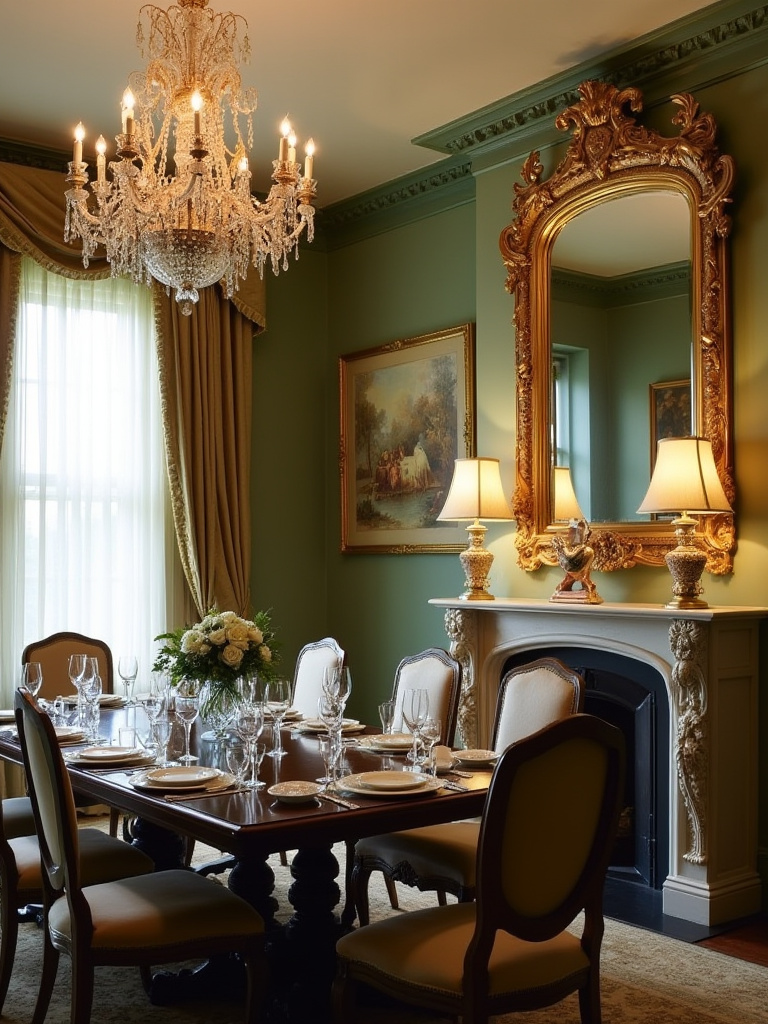
Scale and placement determine success with wall decor. Large pieces work better than small ones in dining rooms, where viewing distances are greater. Hang art at eye level—57-60 inches to the center of the piece—and ensure artwork above furniture measures roughly two-thirds to three-quarters the width of the piece below it. Mirrors opposite windows maximize natural light, while those reflecting your chandelier create dramatic sparkle during evening meals.
- Group smaller pieces into gallery walls rather than scattering them randomly
- Choose frames that complement your room’s wood tones and metallic finishes
- Position mirrors to reflect the most attractive elements of your space
- Consider the stories your art tells and how they contribute to your room’s narrative
The collaboration began with a conversation about how traditional spaces should feel both historically grounded and personally meaningful.
12. Design Stunning Centerpieces for Every Occasion
A well-designed centerpiece serves as the crowning jewel of your traditional dining table, providing a focal point that enhances the dining experience while reflecting the occasion’s significance. The best centerpieces complement rather than compete with your place settings, remaining low enough for easy conversation while adding color, texture, and seasonal relevance. This changeable element allows you to refresh your dining room’s look without major renovations.
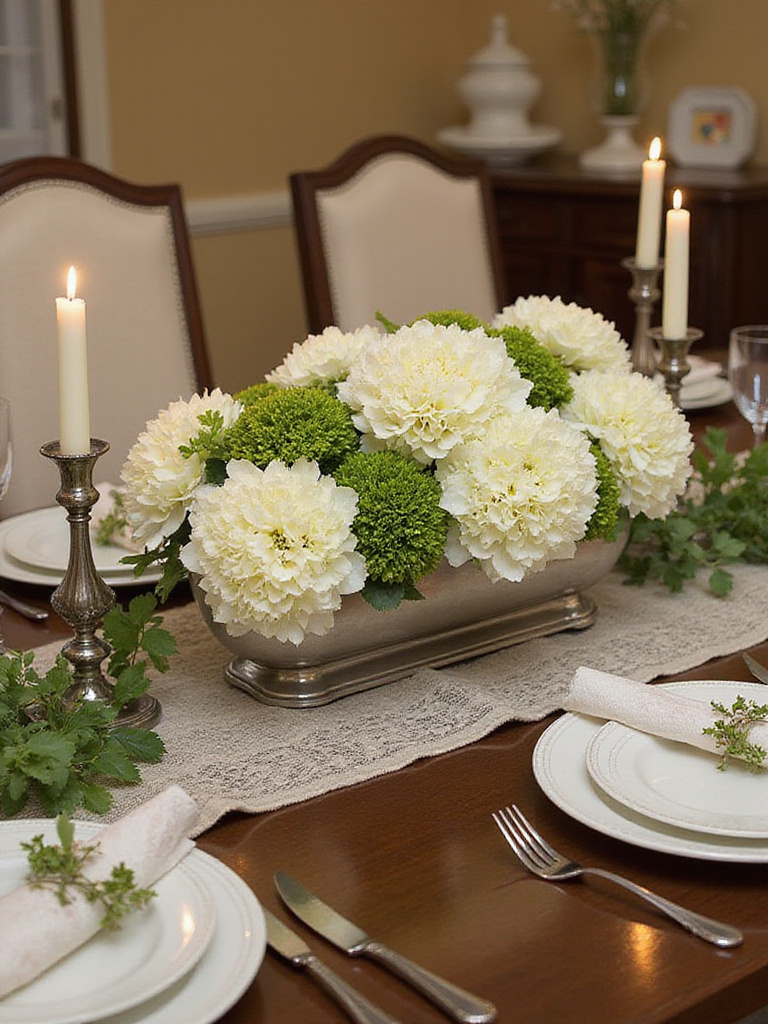
Successful centerpieces follow principles of proportion, balance, and appropriateness. Occupy no more than one-third of your table’s length, keep heights under 12-15 inches for unobstructed sight lines, and choose elements that won’t interfere with food aromas or create safety hazards. Layer different heights and textures—perhaps combining flowers, candles, and decorative objects—while maintaining a cohesive color story that enhances your room’s palette.
- Scale your centerpiece to your table size and the number of diners
- Choose materials that complement your china, crystal, and flatware
- Consider seasonal elements that keep your table feeling fresh and current
- Plan for easy removal or adjustment when serving dishes require table space
The mood shifts dramatically when you add candlelight to your centerpiece, transforming day dining into evening elegance.
13. Master Formal Table Settings for Elegant Dinners
Proper table setting demonstrates respect for your guests while creating the refined atmosphere that traditional dining rooms are designed to showcase. A well-set table guides diners through the meal sequence while contributing to the overall visual appeal of your dining space. This attention to detail transforms ordinary meals into memorable occasions and reflects the gracious hospitality that traditional design celebrates.
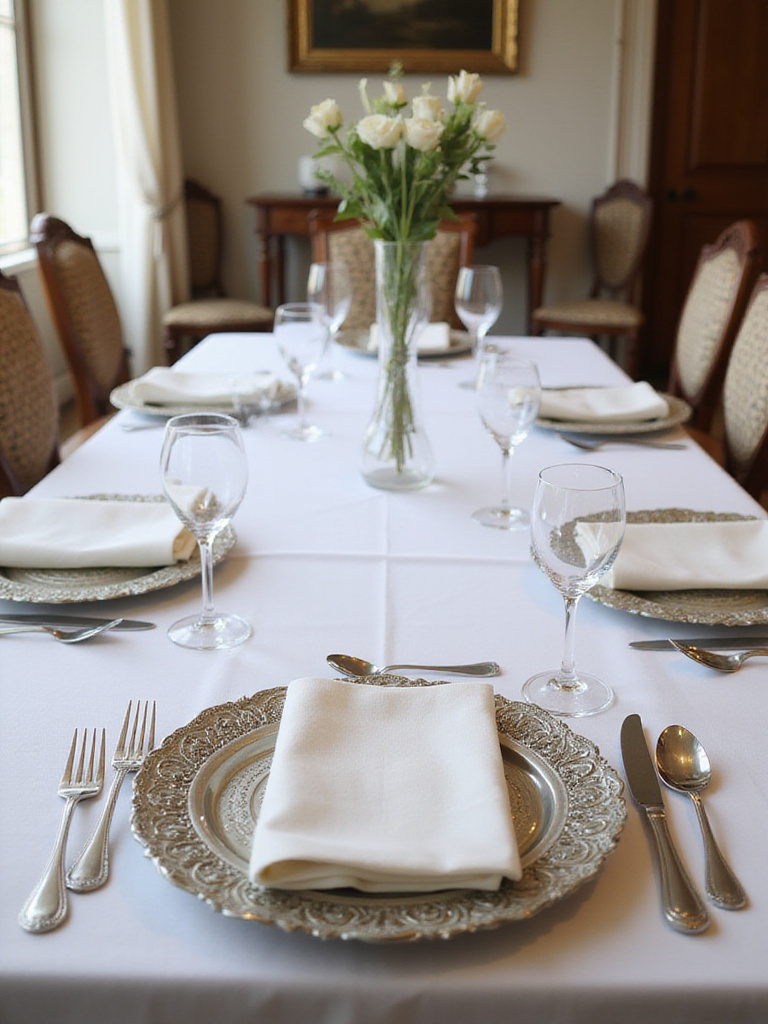
The foundation begins with quality linens and progresses logically from the outside in. Place forks to the left of the charger plate, knives (blades facing inward) and spoons to the right, arranged in order of use from outside to inside. Water goblets sit directly above the dinner knife, with wine glasses positioned to their right. The bread plate belongs at the upper left, with its small butter knife placed diagonally across it.
- Start with crisp, properly pressed linens as your foundation
- Arrange flatware in order of use, working from outside toward the plate
- Position glassware logically above the knives, with water glass closest to the diner
- Ensure consistent spacing and alignment for professional appearance
The finishing touch that elevates the entire look comes from adding personal elements like monogrammed napkins or individual place cards.
14. Integrate Family Heirlooms to Tell Your Story
Family heirlooms transform your traditional dining room from a decorated space into a meaningful reflection of your personal history, creating conversation starters while honoring the generations that came before. These pieces—whether furniture, artwork, or serving pieces—provide authenticity that new purchases cannot match, grounding your design in genuine heritage rather than manufactured nostalgia. The patina and character that develop over decades add depth and soul to traditional interiors.
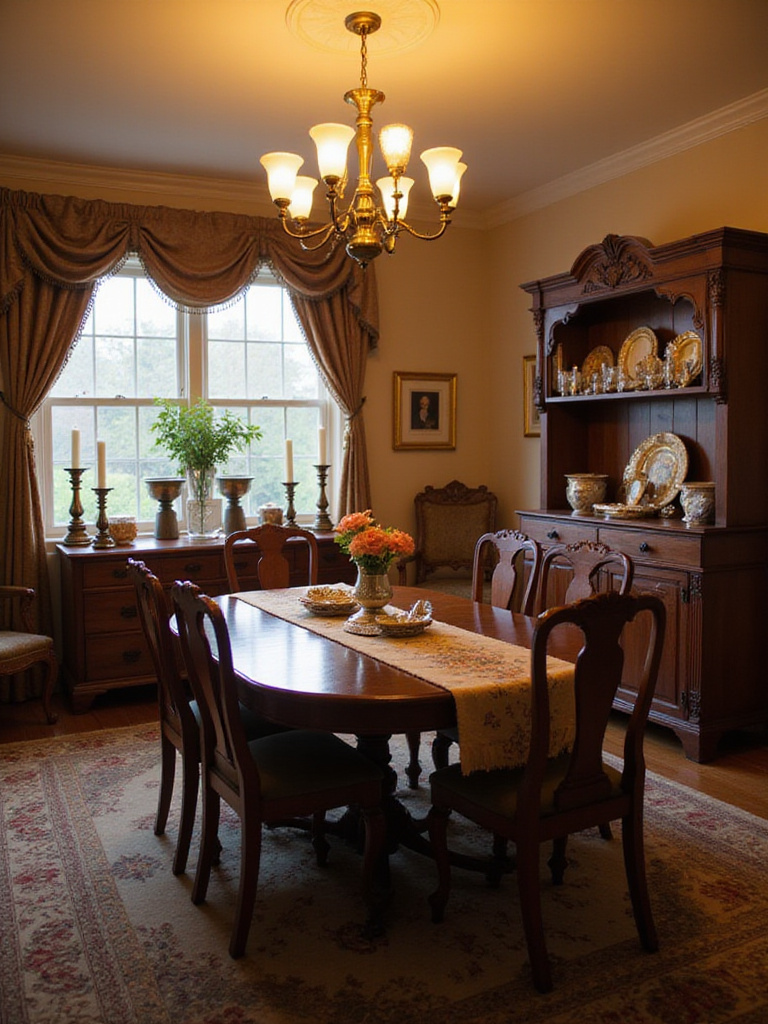
Successful integration requires balancing respect for the past with contemporary functionality. A grandmother’s china cabinet might showcase inherited crystal while storing modern serving pieces, or an antique dining table might be paired with newly upholstered chairs in period-appropriate fabrics. The key lies in allowing heirlooms to be functional rather than museum pieces, ensuring they remain part of daily life rather than untouchable artifacts.
- Assess each heirloom’s condition and restore professionally if needed
- Position larger pieces as focal points while using smaller items as accents
- Mix heirlooms with contemporary pieces to avoid a museum-like atmosphere
- Document and share the stories behind significant pieces with family and guests
The third-generation workshop where this comes to life understands that furniture should serve families, not sit unused in storage.
15. Infuse Personality While Maintaining Tradition
Adding personal touches to your traditional dining room ensures the space reflects your unique story while maintaining the timeless appeal that drew you to this aesthetic. The challenge lies in incorporating contemporary elements or personal collections without compromising the room’s classical integrity. Success comes from choosing additions that complement rather than clash with traditional principles of proportion, quality, and refined elegance.
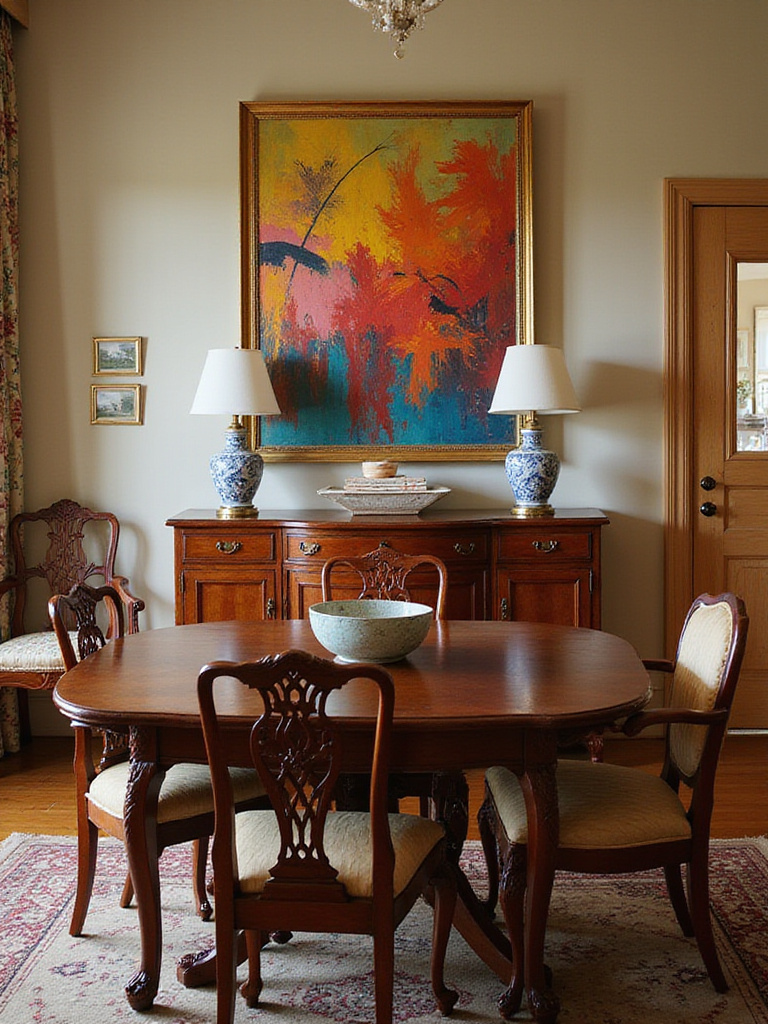
Personal elements might include contemporary art that echoes traditional color palettes, collections displayed thoughtfully within classic furniture, or modern lighting fixtures that respect traditional scale and materials. The key is restraint—allow personal touches to enhance rather than overwhelm the traditional foundation. Consider how each addition contributes to the room’s narrative while respecting the design principles that make traditional spaces enduringly appealing.
- Apply the 80/20 rule: maintain 80% traditional elements with 20% personal flair
- Choose personal additions that complement your traditional color palette and materials
- Display collections within classic furniture rather than on modern shelving
- Ensure personal elements enhance rather than compete with architectural details
The design language evolved from traditional patterns that celebrated both heritage and individual expression within established frameworks.
16. Choose Timeless Flooring Materials for Durability
Your flooring choice provides the literal foundation for your traditional dining room design, affecting everything from acoustics to visual warmth while needing to withstand decades of foot traffic, chair movement, and occasional spills. Quality materials like solid hardwood, natural stone, or premium tile not only provide durability but also develop character over time, becoming more beautiful with age rather than simply wearing out.

Hardwood remains the gold standard for traditional dining rooms, offering warmth, natural beauty, and the ability to be refinished multiple times throughout its century-plus lifespan. Oak, maple, cherry, and walnut provide different aesthetic options while all delivering exceptional durability. For areas prone to moisture or high traffic, natural stone or porcelain tiles that mimic wood or stone can provide similar beauty with enhanced practicality.
- Prioritize solid materials over manufactured alternatives for longevity and authenticity
- Consider your specific usage patterns when selecting materials and finishes
- Factor long-term maintenance requirements into your decision-making process
- Choose colors and patterns that will remain appealing for decades, not just seasons
The sustainable journey of this material involves forests managed for continuous regeneration, ensuring beauty that doesn’t compromise future generations.
17. Enhance Walls with Classic Paneling or Wallpaper
Wall treatments like wainscoting, raised panels, or traditional wallpaper patterns add architectural interest and historical authenticity that flat painted walls cannot achieve. These elements create visual depth, protect walls from chair damage, and provide the kind of detailed craftsmanship that defines quality traditional interiors. The right wall treatment can transform a simple room into a sophisticated space with genuine character and presence.

Wainscoting typically extends one-third to one-half up the wall, providing an elegant transition between upper and lower wall treatments while offering practical protection in high-traffic areas. Traditional wallpaper patterns like damask, toile, or botanical prints can add color and pattern while maintaining historical appropriateness. The key lies in choosing treatments that complement your room’s proportions and existing architectural details rather than overwhelming them.
- Select wall treatments that match your home’s architectural period and style
- Ensure proper proportion between wainscoting height and ceiling height
- Choose wallpaper patterns that enhance rather than compete with your furnishings
- Consider how wall treatments will interact with your lighting and furniture placement
The unexpected environmental benefit comes from using traditional materials and techniques that often prove more durable than modern alternatives.
18. Improve Room Acoustics for Comfortable Conversation
Hard surfaces in traditional dining rooms—wood floors, plaster walls, glass windows—can create echo and reverberation that makes conversation difficult and meals less enjoyable. Strategic acoustic treatment using traditional materials and furnishings can dramatically improve sound quality without compromising aesthetic appeal. The goal is creating an environment where normal conversation carries clearly without requiring raised voices or straining to hear.
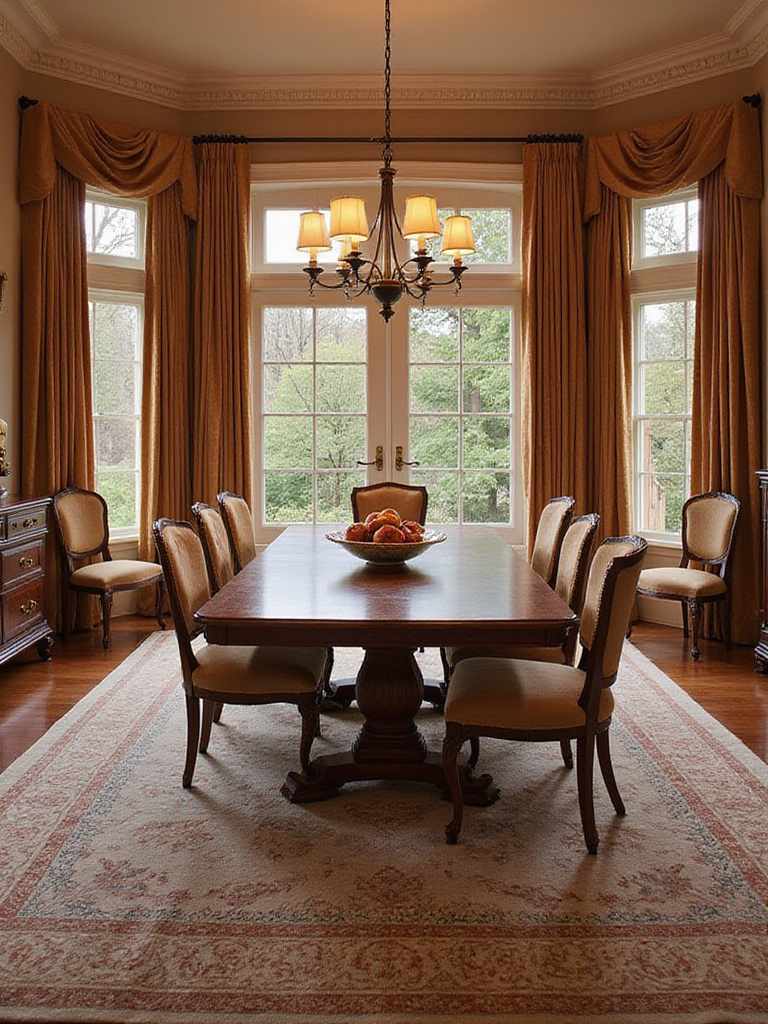
Soft furnishings provide the most effective acoustic treatment while enhancing traditional aesthetics. Area rugs absorb impact noise, upholstered chairs reduce sound reflection, and drapery panels soften window surfaces. Even decorative elements like tapestries, fabric wall hangings, or upholstered dining banquettes contribute to acoustic comfort while maintaining traditional design principles.
- Layer multiple soft materials for cumulative acoustic benefit
- Choose fabrics and textures that complement your traditional aesthetic
- Position sound-absorbing elements strategically around the room’s perimeter
- Consider how furniture arrangement affects sound reflection and conversation flow
The ambiance evolves throughout the day as natural light changes, but proper acoustics ensure conversation remains comfortable regardless of the hour.
19. Preserve Wood Furniture with Proper Care Techniques
Quality wood furniture represents a significant investment that, with proper care, can serve multiple generations while developing the rich patina that makes traditional pieces increasingly beautiful over time. Understanding your furniture’s specific needs—whether it’s antique mahogany, new cherry, or painted wood—ensures you’re protecting rather than inadvertently damaging these valuable pieces. Proper maintenance prevents costly repairs while preserving both monetary and sentimental value.
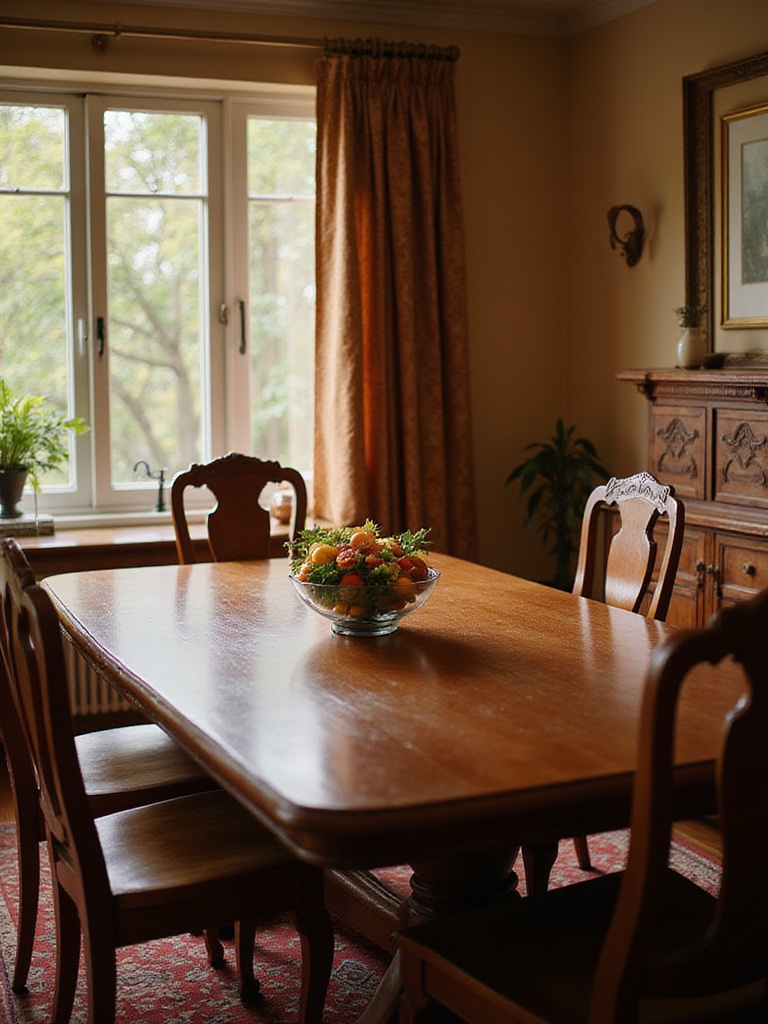
Regular dusting with microfiber cloths removes abrasive particles that can scratch finishes, while immediate attention to spills prevents water damage and staining. Environmental factors matter enormously—maintaining 40-55% humidity prevents cracking and warping, while keeping furniture away from direct sunlight and heat sources preserves color and finish integrity. Periodic conditioning with appropriate products maintains wood’s natural oils and protective finish.
- Establish regular cleaning routines using appropriate products for your furniture’s finish
- Monitor and control environmental conditions that affect wood stability
- Address spills and damage immediately to prevent permanent harm
- Understand your furniture’s specific care requirements based on wood type and finish
The traditional methods used result in furniture that actually improves with age when properly maintained, developing character impossible to achieve artificially.
20. Prepare Your Dining Room for Elegant Gatherings
Transforming your traditional dining room from everyday space to elegant entertainment venue requires systematic preparation that addresses every detail guests might notice. This preparation extends beyond table setting to encompass lighting, temperature, acoustics, and even subtle touches like fresh flowers or background music. The goal is creating an atmosphere where both hosts and guests can relax and enjoy the occasion without distraction or discomfort.

Successful preparation begins days before your event with deep cleaning, polishing, and organizing. Set your table completely, then cover it with a sheet to protect against dust while allowing last-minute adjustments. Check lighting levels at different times of day, ensure comfortable seating for all guests, and prepare serving areas with necessary items. Consider guest comfort factors like coat storage, restroom supplies, and even small amenities like phone chargers.
- Create detailed preparation checklists to ensure nothing is overlooked
- Test all lighting scenarios and adjust for optimal ambiance
- Prepare serving areas and staging spaces for smooth meal progression
- Consider guest comfort needs beyond the dining table itself
The emotional response this evokes begins with guests feeling welcomed and cared for from the moment they enter your thoughtfully prepared space.
21. Invest Wisely in Key Traditional Dining Pieces
Quality traditional dining furniture represents a generational investment that, chosen wisely, provides decades of service while potentially appreciating in value. The key lies in identifying pieces that combine excellent craftsmanship, timeless design, and appropriate scale for your space. These foundational elements—dining table, chairs, and storage pieces—form the backbone of your traditional dining room and deserve careful consideration and adequate budget allocation.
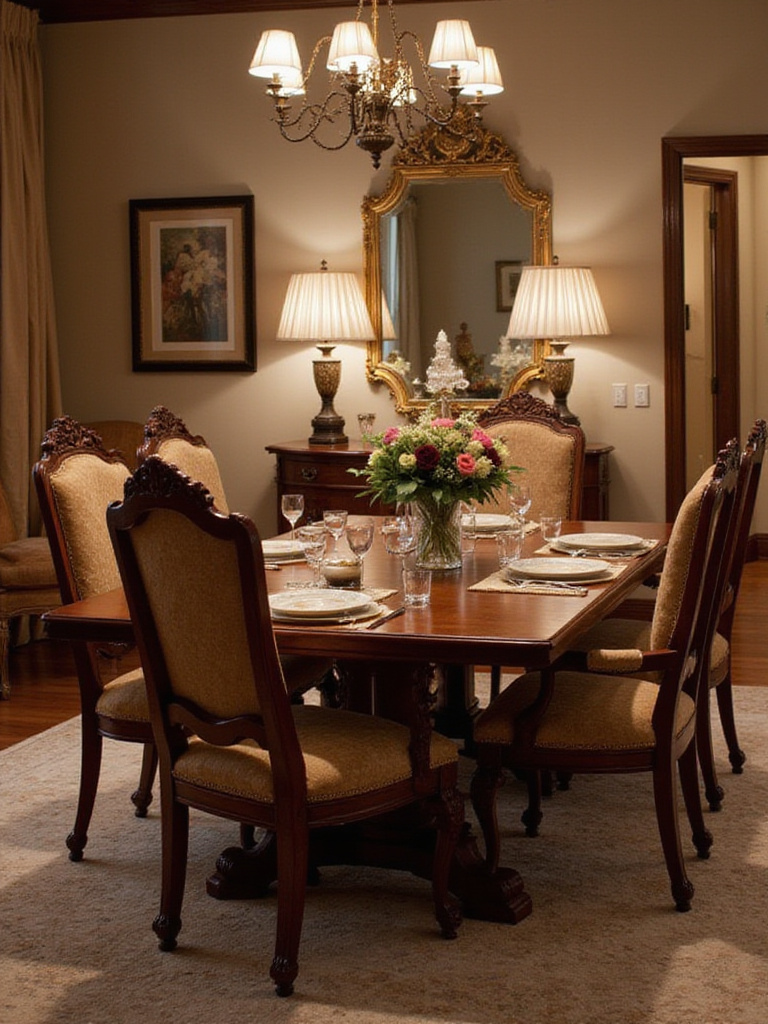
Solid wood construction, traditional joinery methods like mortise and tenon, and proven designs from established periods indicate pieces likely to endure both physically and aesthetically. Research manufacturers known for quality, examine construction details personally when possible, and consider custom options for perfect fit and specifications. While initial investment may be substantial, quality pieces often cost less over time than repeated replacements of inferior alternatives.
- Focus investment on core pieces that define your room’s character and functionality
- Research construction methods and materials to identify quality indicators
- Consider custom options for perfect scale and personalization
- Factor long-term value and durability into purchase decisions
The artisans’ commitment to environmental practices means choosing pieces built to last rather than contributing to disposable furniture culture.
22. Blend Modern Elements for a Fresh Traditional Look
Introducing carefully selected contemporary elements prevents traditional dining rooms from feeling like museum displays while maintaining their classical foundation. This approach creates dynamic visual interest through contrast and keeps the space feeling current and personally relevant. The key lies in choosing modern additions that complement rather than clash with traditional proportions, materials, and color palettes.

Successful blending might involve pairing a traditional mahogany table with contemporary upholstered chairs, hanging modern art above classic wainscoting, or installing sleek pendant lighting over antique furniture. The modern elements should share some characteristic with their traditional counterparts—perhaps similar scale, complementary colors, or analogous materials—to create harmony despite stylistic differences.
- Maintain traditional foundations while introducing modern accents strategically
- Choose contemporary pieces that share scale or material characteristics with traditional elements
- Use consistent color palettes to unify different stylistic periods
- Allow modern elements to enhance rather than overwhelm traditional character
The revival of this classic form comes with a twist that honors historical precedent while acknowledging contemporary lifestyle needs.
23. Ensure Lasting Appeal with Enduring Design Choices
Creating a traditional dining room with genuine staying power requires choosing elements that transcend temporary trends while maintaining their beauty and relevance across decades. This approach focuses on quality materials, classic proportions, and proven design principles that have demonstrated their appeal across generations. The goal is creating a space that feels as appropriate and beautiful in twenty years as it does today.
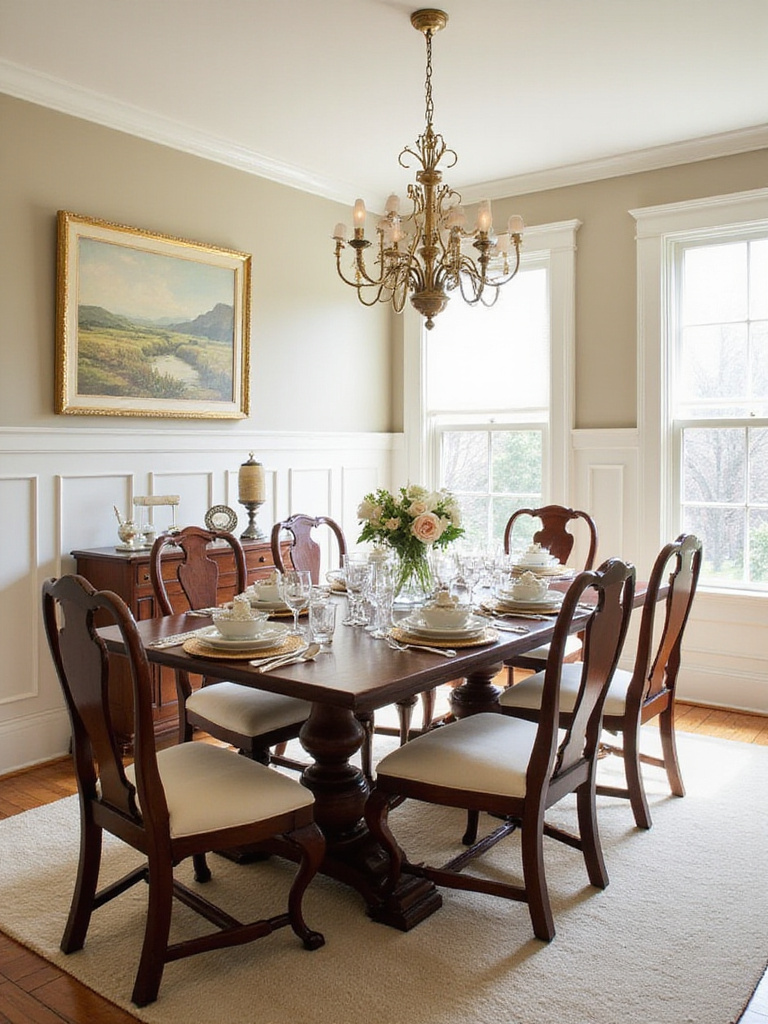
Enduring choices prioritize natural materials like solid wood and stone, classic color palettes that won’t date quickly, and furniture designs with historical precedent and proven appeal. These elements provide the stable foundation that allows for minor updates and personal touches without requiring complete redesign. Investment in quality pays dividends through longevity, reduced maintenance, and sustained aesthetic appeal.
- Select materials and finishes that age gracefully rather than simply wearing out
- Choose furniture designs with historical precedent and proven longevity
- Build your foundation with neutral, sophisticated color palettes
- Prioritize quality construction that will withstand decades of use
The cultural heritage preserved in each piece includes not just historical design traditions, but the values of craftsmanship and permanence that traditional style celebrates.
Conclusion
Creating a timeless traditional dining room requires balancing respect for historical design principles with contemporary functionality and personal expression. Each of these 23 essential tips contributes to a cohesive approach that honors the past while serving present-day needs. From selecting properly scaled furniture to preserving precious heirlooms, every decision shapes a space that can serve your family for generations while maintaining its elegant appeal.
The beauty of traditional design lies in its proven ability to create rooms that feel both sophisticated and welcoming, formal yet comfortable. By investing in quality pieces, paying attention to proportion and detail, and incorporating personal touches thoughtfully, you create more than just a dining room—you craft a gathering place where memories are made and traditions are honored.
Begin with careful planning and measurement, then build your room systematically, focusing on foundational elements before adding decorative touches. Remember that true traditional style develops over time, gaining character and meaning as it becomes part of your family’s story. Your thoughtfully designed traditional dining room will reward you with decades of elegant gatherings and cherished memories.

